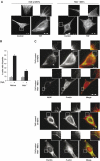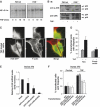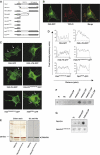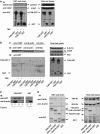PtdIns(4,5)P-restricted plasma membrane localization of FAN is involved in TNF-induced actin reorganization
- PMID: 17599063
- PMCID: PMC1933409
- DOI: 10.1038/sj.emboj.7601778
PtdIns(4,5)P-restricted plasma membrane localization of FAN is involved in TNF-induced actin reorganization
Abstract
The WD-repeat protein factor associated with nSMase activity (FAN) is a member of the family of TNF receptor adaptor proteins that are coupled to specific signaling cascades. However, the precise functional involvement of FAN in specific cellular TNF responses remain unclear. Here, we report the involvement of FAN in TNF-induced actin reorganization and filopodia formation mediated by activation of Cdc42. The pleckstrin-homology (PH) domain of FAN specifically binds to phosphatidylinositol-4,5-bisphosphate (PtdIns(4,5)P), which targets FAN to the plasma membrane. Site-specific mutagenesis revealed that the ability of FAN to mediate filopodia formation was blunted either by the destruction of the PtdIns(4,5)P binding motif, or by the disruption of intramolecular interactions between the PH domain and the adjacent beige and Chediak-Higashi (BEACH) domain. Furthermore, FAN was shown to interact with the actin cytoskeleton in TNF-stimulated cells via direct filamentous actin (F-actin) binding. The results of this study suggest that PH-mediated plasma membrane targeting of FAN is critically involved in TNF-induced Cdc42 activation and cytoskeleton reorganization.
Figures







Similar articles
-
Multiple signal transduction pathways regulate TNF-induced actin reorganization in macrophages: inhibition of Cdc42-mediated filopodium formation by TNF.J Immunol. 1999 Jan 15;162(2):837-45. J Immunol. 1999. PMID: 9916706
-
The pleckstrin homology domain proteins Slm1 and Slm2 are required for actin cytoskeleton organization in yeast and bind phosphatidylinositol-4,5-bisphosphate and TORC2.Mol Biol Cell. 2005 Apr;16(4):1883-900. doi: 10.1091/mbc.e04-07-0564. Epub 2005 Feb 2. Mol Biol Cell. 2005. PMID: 15689497 Free PMC article.
-
Activation of the small GTPase Cdc42 by the inflammatory cytokines TNF(alpha) and IL-1, and by the Epstein-Barr virus transforming protein LMP1.J Cell Sci. 1999 Sep;112 ( Pt 17):2983-92. doi: 10.1242/jcs.112.17.2983. J Cell Sci. 1999. PMID: 10444392
-
Frabin and other related Cdc42-specific guanine nucleotide exchange factors couple the actin cytoskeleton with the plasma membrane.J Cell Mol Med. 2008 Aug;12(4):1169-76. doi: 10.1111/j.1582-4934.2008.00345.x. Epub 2008 Apr 9. J Cell Mol Med. 2008. PMID: 18410521 Free PMC article. Review.
-
The actin cytoskeleton and plasma membrane connection: PtdIns(4,5)P(2) influences cytoskeletal protein activity at the plasma membrane.J Cell Sci. 2000 Nov;113 Pt 21:3685-95. doi: 10.1242/jcs.113.21.3685. J Cell Sci. 2000. PMID: 11034897 Review.
Cited by
-
TNF-receptor-1 adaptor protein FAN mediates TNF-induced B16 melanoma motility and invasion.Br J Cancer. 2013 Jul 23;109(2):422-32. doi: 10.1038/bjc.2013.242. Epub 2013 May 14. Br J Cancer. 2013. PMID: 23674089 Free PMC article.
-
Intracellular Theileria annulata promote invasive cell motility through kinase regulation of the host actin cytoskeleton.PLoS Pathog. 2014 Mar 13;10(3):e1004003. doi: 10.1371/journal.ppat.1004003. eCollection 2014 Mar. PLoS Pathog. 2014. PMID: 24626571 Free PMC article.
-
Filopodia and membrane blebs drive efficient matrix invasion of macrophages transformed by the intracellular parasite Theileria annulata.PLoS One. 2013 Sep 24;8(9):e75577. doi: 10.1371/journal.pone.0075577. eCollection 2013. PLoS One. 2013. PMID: 24086576 Free PMC article.
-
TILRR, a novel IL-1RI co-receptor, potentiates MyD88 recruitment to control Ras-dependent amplification of NF-kappaB.J Biol Chem. 2010 Mar 5;285(10):7222-32. doi: 10.1074/jbc.M109.073429. Epub 2009 Nov 25. J Biol Chem. 2010. PMID: 19940113 Free PMC article.
-
Molecular Dissection of Neurobeachin Function at Excitatory Synapses.Front Synaptic Neurosci. 2018 Aug 15;10:28. doi: 10.3389/fnsyn.2018.00028. eCollection 2018. Front Synaptic Neurosci. 2018. PMID: 30158865 Free PMC article.
References
-
- Abramoff M, Magelhaes P, Ram S (2004) Image processing with ImageJ. Biophotonics International 11: 36–42
-
- Adam D, Wiegmann K, Adam-Klages S, Ruff A, Krönke M (1996) A novel cytoplasmic domain of the p55 tumor necrosis factor receptor initiates the neutral sphingomyelinase pathway. J Biol Chem 271: 14617–14622 - PubMed
-
- Adam-Klages S, Adam D, Wiegmann K, Struve S, Kolanus W, Schneider-Mergener J, Krönke M (1996) FAN, a novel WD-repeat protein, couples the p55 TNF-receptor to neutral sphingomyelinase. Cell 86: 937–947 - PubMed
-
- Adam-Klages S, Schwandner R, Adam D, Kreder D, Bernardo K, Krönke M (1998) Distinct adapter proteins mediate acid versus neutral sphingomyelinase activation through the p55 receptor for tumor necrosis factor. J Leukoc Biol 63: 678–682 - PubMed
-
- Banno T, Gazel A, Blumenberg M (2004) Effects of tumor necrosis factor-alpha (TNF alpha) in epidermal keratinocytes revealed using global transcriptional profiling. J Biol Chem 279: 32633–32642 - PubMed
MeSH terms
Substances
LinkOut - more resources
Full Text Sources
Molecular Biology Databases
Miscellaneous

